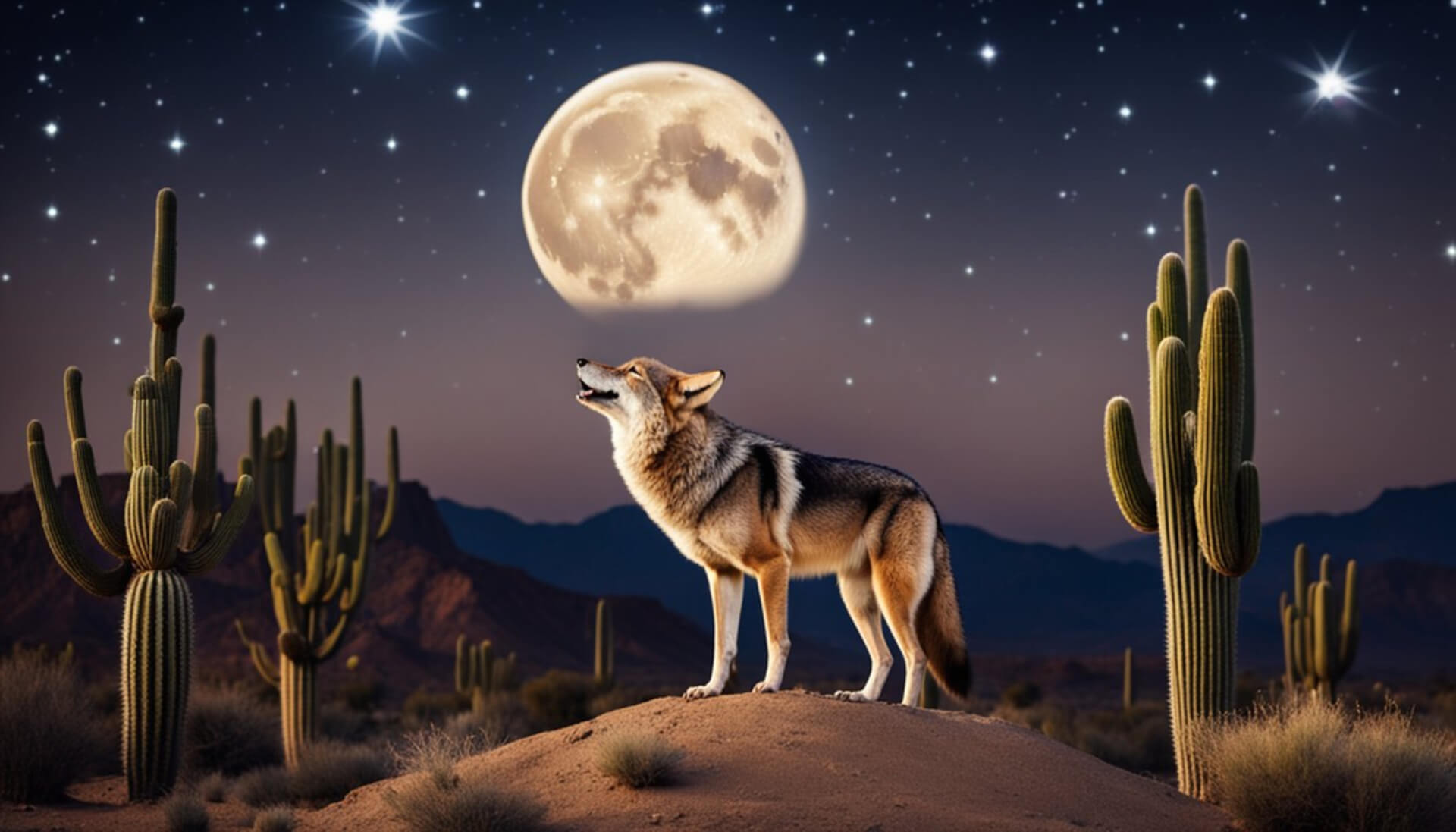The coyote spirit animal holds a complex and enthralling place in the spiritual realm. Known for its cunning and adaptability, the coyote is often seen as a guide who helps individuals navigate the twists and turns of life.
People who identify with the coyote spirit animal are believed to be able to deal with challenges in innovative ways because of its intelligence, playfulness, and resourcefulness.
In various cultures, particularly within Native American traditions, the coyote has been revered as a creature of profound symbolism and importance. Its depiction and stories have conveyed wisdom and the balance between lightness and seriousness.
Today, the coyote spirit animal continues to be a powerful symbol for personal growth, teaching the importance of adaptability and hidden wisdom in seemingly chaotic situations.
Historical Significance of the Coyote in Native American Culture

In Native American traditions, the coyote has played a multifaceted role, from a cunning trickster in folklore to a powerful totem for various tribes.
Coyote in Mythology and Folklore
The coyote is a central figure in Native American mythology, especially among tribes in the Plains, California, and the Southwest. These tribes recount tales of the coyote as a creator and a trickster who uses his wits to influence the world around him.
The stories often depict the coyote as making significant decisions that impact both the natural and supernatural realms.
In many Native American folklore narratives, the coyote’s tales are a complex blend of morality, demonstrating his intelligence, creativity, and sometimes mischievous tendencies.
For instance, in some ancient stories, he might bring fire to humanity or play tricks on other animals.
Coyote as a Tribal Totem
The coyote is an important tribal totem in Native American culture. It symbolizes wisdom, adaptability, and survival skills.
Different tribes attribute various qualities to the coyote spirit, often reflecting the community’s values and the environment they inhabit.
The coyote’s role as a totem is significant. It acts as a guardian spirit for those it represents and teaches important life lessons.
Traditions vary, but the presence of a coyote as a tribal totem often encourages reflection on personal and communal behavior.
Through the reverence of the coyote in their culture, Native American tribes continue to honor the complex relationship between humans, animals, and the spiritual world that is deeply embedded in their heritage and tales.
Symbolism and Spiritual Meaning of the Coyote
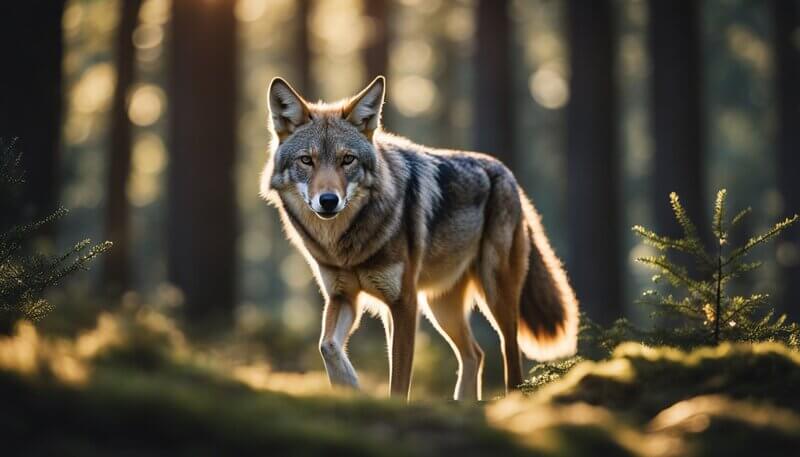
The coyote holds a multifaceted place in symbolism and spiritual meaning. It represents a blend of complex traits, such as adaptability and wisdom, explored in the following subsections.
Coyote as a Symbol for Life’s Balancing Acts
The coyote is often seen as a representation of the duality inherent in life. This creature embodies balance, constantly navigating the contradictory forces of nature and society.
To some, the coyote signifies the tightrope between wisdom and folly, demonstrating how one can move through life’s challenges with grace.
Cunning and Trickster Energy
Recognized for its cunning, the coyote also signifies the trickster energy.
In various mythologies, the coyote uses its sharp intellect and guile to navigate tricky scenarios, often playing the role of the provocateur.
Its trickster persona reminds of the significance of using wit and intelligence to adapt to unforeseen circumstances.
Coyote as a Guide and Teacher
As a guide and teacher, the coyote spirit animal is believed to offer direction and insight.
It presents itself as a sign or omen indicating a need to pay attention to one’s intuition and lessons unfolding in one’s life.
The coyote’s role as a spiritual guide emphasizes the importance of flexibility and the ability to learn from the environment.
Coyote Behavioral Traits and Personality
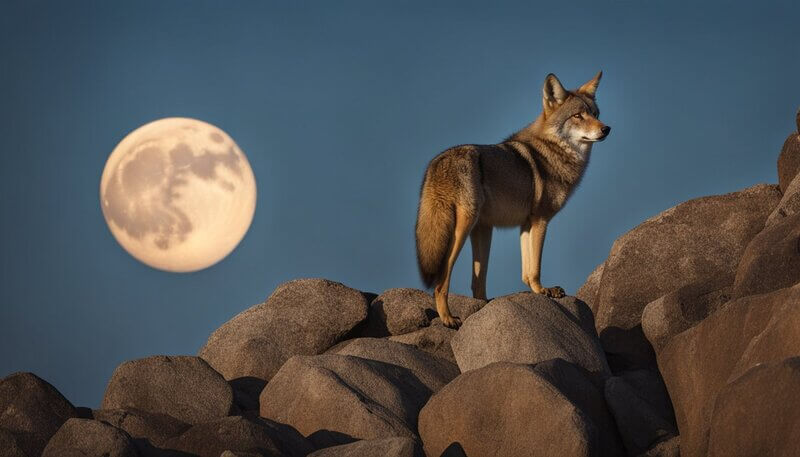
The coyote spirit animal is renowned for its distinctive behavioral traits and personality, which resonate with human characteristics of adaptability, intelligence, and a penchant for humor and playfulness.
Adaptability and Resourcefulness
Coyotes are symbols of remarkable adaptability and resourcefulness. These animals can thrive in diverse environments, from urban locales to deserts, showcasing their ability to adjust and make the most of their available resources.
Their instinct-driven survival skills are often seen as guidance for individuals to navigate life’s unpredictable challenges.
Inquisitive Nature and Intelligence
Curiosity and intelligence define coyote behavior.
They possess a keen sense of their surroundings, constantly exploring and learning, which reflects a message to stay curious and knowledgeable.
The coyote’s cleverness is instinctual and strategic, indicating an ability to think and adapt quickly to solve complex problems.
Sense of Humor and Playfulness
Coyotes are notorious for being sly tricksters, often engaged in mischief and playing pranks.
This behavior exemplifies a unique sense of humor and playfulness, serving as a reminder not to take life too seriously.
Embracing the lighter side of things and finding joy even in mundane circumstances is a key lesson drawn from their spirited antics.
Life Lessons and Personal Growth from the Coyote Spirit

The coyote spirit animal represents adaptability and cunning, offering profound insights for personal growth and life lessons. It embodies transformation and the resilience required to face life’s myriad challenges.
The following subsections will explore the specific lessons imbued by the coyote’s essence.
Embracing Change and Transformation
The coyote spirit teaches one to remain flexible, as change is a constant element of life.
Those guided by the coyote’s adaptability learn to navigate life’s unexpected twists gracefully.
This ability to pivot when necessary can lead to transformative personal growth, allowing individuals to thrive in various environments and situations.
Persistence and Resilience in Facing Challenges
Resilience is at the core of the coyote’s teachings.
Observing the coyote’s tenacity in the wild—how it continues to survive and flourish despite obstacles—can teach individuals valuable life lessons about persistence.
They discover the fortitude to endure and surmount life’s challenges, recognizing that each trial can contribute to their strength and character development.
Independent Thinking and Problem-Solving
The coyote is known for its cleverness and ability to work through challenges with inventive problem-solving skills.
People can take inspiration from this trait, learning to trust their intuition and think independently when confronting difficulties.
Independent thinking fosters a strong sense of self-reliance and confidence, which are essential for personal growth and navigating the complexities of life.
Coyote Spirit in Dreams and Visions

When individuals encounter the coyote spirit in dreams or visions, it is often perceived as a powerful symbol of transformation and guidance.
Related: Dream moods dictionary
Dreams are considered a window into one’s subconscious, where the coyote can appear as an omen or a manifestation of insight.
- In dreams, the coyote may represent:
- Intuition: Guiding dreamers to trust their instincts.
- Adaptability: Encouraging flexibility in navigating life’s challenges.
- Cleverness: Suggesting the use of intelligence to solve problems.
The vision of a coyote can prompt a person to pay attention to their surroundings or to a situation that requires a thoughtful approach.
In various cultural traditions, a vision of a coyote is sometimes seen as a messenger, bringing forth messages that demand interpretation and understanding.
In the context of inner work or spiritual meditation, the appearance of a coyote calls for reflection, underscoring the importance of self-discovery.
- Subconscious cues in coyote encounters might indicate:
- Resilience: Emphasizing strength in adversity.
- Wisdom: Highlighting the value of learning from experiences.
Note: The information presented here reflects interpretations found in cultural stories and personal spiritual beliefs and should not be taken as universally accepted truths or scientific facts.
Interconnecting with the Spirit Animal Realm

In the domain of spirit animals, the coyote often emerges as a figure of connection and guidance. This nimble canid is a totem of wisdom and bridges the gap between humans and animals, encouraging community and support.
Related: How to Find Your Spirit Animal
The Role of Coyote as a Connector
The coyote is renowned for its ability to traverse various environments, making it a potent connector within the spirit animal realm. It exemplifies adaptability and heralds the importance of being open to life’s multitude of experiences.
Those drawn to the coyote spirit animal might become adept at navigating diverse social landscapes and fostering community wherever they go.
It’s not uncommon for these individuals to act as protectors or guides, imparting their knowledge and intuition to aid others.
Building a Relationship with Your Spirit Guide
The coyote calls for an attentive and respectful approach to cultivate a relationship with your spirit guide.
Begin by taking time to meditate and invite the presence of your coyote guide into your consciousness.
Pay close attention to the messages and insights they might offer through dreams or symbolic occurrences in your daily life.
Building this connection can lead to a profound sense of support and guidance.
With the coyote as your guardian spirit, you’re encouraged to embrace resourcefulness and adaptability in pursuing your life’s path.
Cultural Representation and the Modern-day Significance of the Coyote
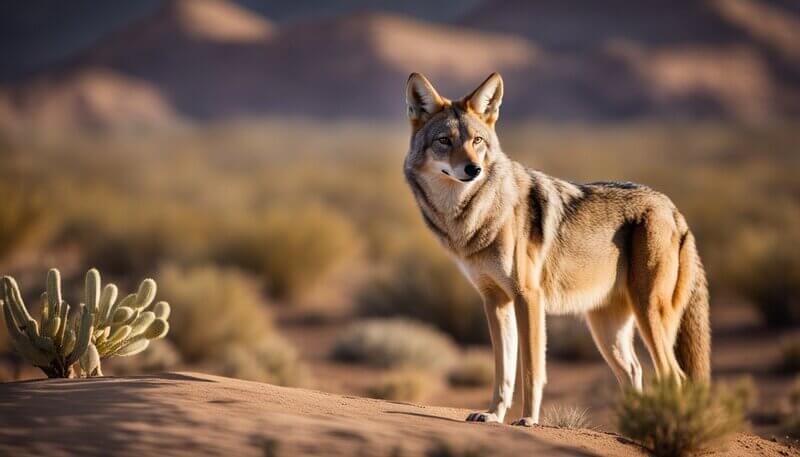
The coyote has evolved from consistent cultural representation in indigenous narratives to a modern-day emblem of adaptability in changing environments. This transition highlights the coyote’s enduring significance and symbolic resonance in contemporary life, even within urban landscapes.
Coyote’s Resonance in Contemporary Life
In North America, the coyote has long been a significant animal in indigenous cultures, often seen as a trickster or a wise being.
Today, the coyote embodies the spirit of adaptation as it navigates the challenges of modern living.
In recent years, the coyote’s image has transcended folklore, becoming a metaphor for survival and resourcefulness in everyday contemporary life.
As humans grapple with the balance between progression and tradition, the coyote’s ability to thrive in diverse conditions offers inspiration.
Coyote Spirit’s Adaptation to Urban Environments
Against increasing urbanization, the coyote has demonstrated remarkable adaptation to urban environments.
Far from being confined to their traditional habitats, coyotes are now a common sight in cities across North America.
This successful adaptation is a testament to their versatility and intelligence as they learn to coexist alongside human residents.
Engaging with the modern-day significance of the coyote encourages people to reflect on the relationship between wildlife and urban development and consider cohabitation strategies that honor the needs of all species involved.
Related: Spirit animal by birthday
Frequently Asked Questions
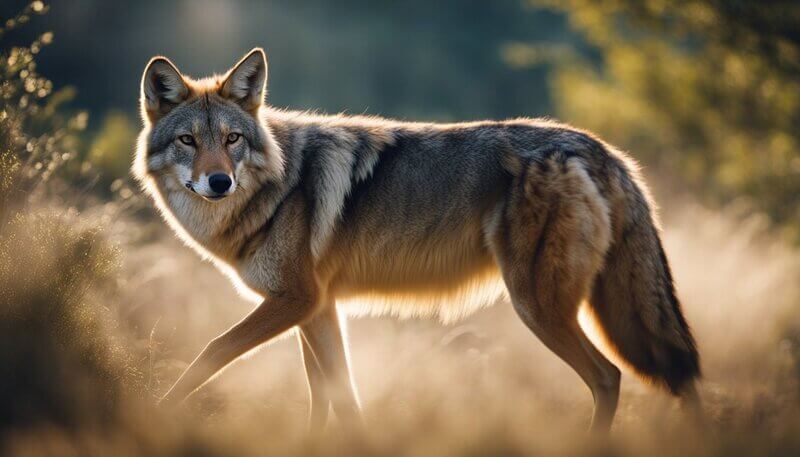
This section addresses some of the most common inquiries about coyote spirit animals, offering insights into their symbolism and significance.
1. What are the common interpretations of encountering a coyote during daytime?
Daytime encounters with coyotes are often viewed as a sign to be mindful of the opportunities and challenges in one’s life.
These encounters may suggest a need for adaptation and flexibility in the face of change.
2. How is the coyote spirit animal described in terms of personality traits and characteristics?
The coyote spirit animal is typically associated with intelligence, playfulness, and resourcefulness. It embodies the trickster motif and can teach essential life lessons.
3. What significance is attributed to the sighting of a coyote at nighttime?
Sightings of coyotes at nighttime are believed to carry messages of wisdom and hidden truths.
It may indicate unveiling something that was once concealed or prompting to explore one’s intuition and instincts more deeply.
4. Can you explain the spiritual implications of a coyote crossing someone’s path?
When a coyote crosses one’s path, it may signify an impending shift in one’s life.
This event is often interpreted as a call to be alert and aware, potentially signaling that one should consider different perspectives.
5. In what ways does the appearance of a black or red coyote influence its spiritual meaning?
Color variations in coyote appearances can augment their spiritual meaning. A black coyote might symbolize the unknown or the unconscious, while a red coyote could indicate passion, survival instincts, and strong emotions.
6. How do coyotes represent cultural beliefs or symbolism in Native American traditions?
In Native American cultures, coyotes are revered for their role as creators and wise tricksters. They also represent a figure of paradox and hold profound cultural significance.
Coyotes are often central characters in stories that convey moral lessons and cultural values.

